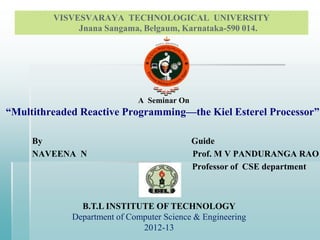Multithreaded reactive programmingŌĆöthe kiel esterel processor
- 1. VISVESVARAYA TECHNOLOGICAL UNIVERSITY Jnana Sangama, Belgaum, Karnataka-590 014. A Seminar On ŌĆ£Multithreaded Reactive ProgrammingŌĆöthe Kiel Esterel ProcessorŌĆØ By Guide NAVEENA N Prof. M V PANDURANGA RAO Professor of CSE department B.T.L INSTITUTE OF TECHNOLOGY Department of Computer Science & Engineering 2012-13
- 2. A G E N D A oAbstract o Esterel Language oExisting system oProposed System oMultithreaded reactive architectures oApplications oConclusion
- 3. A B S T R A C T ’āś The Kiel Esterel Processor (KEP). ’āś The KEP directly supports EsterelŌĆÖs reactive control flow operators, notably concurrency and various types of preemption, through dedicated control units. ’āś Esterel allows arbitrary combinations and nesting of these operators, which poses particular implementation challenges. ’āś Instruction set architecture , Tick Manager.
- 4. Esterel Language ’é¦ MANY embedded systems belong to the class of reactive systems, which continuously react to inputs from the environment by generating corresponding outputs. ’é¦ An Esterel program is typically validated via a simulation- based tool set, and then, synthesized to an intermediate language. ’é¦ Frequent context switches. ’é¦ Preemption.
- 5. ’é¦ Esterel program is divided into logical instants, or ticks, and communication within or across threads occurs via signals. ’é¦ At each tick, a signal is either present (emitted) or absent (not emitted). ’é¦ Esterel offers two types of preemption constructs, abortion, and suspension. ’é¦ Esterel also offers an exception handling mechanism via the trap/exit statements. Esterel Language
- 6. ’āś EXAMPLE
- 7. EXISTING SYSTEM ’é¦ The first reactive processor, called REFLIX(patched processor). ’é¦ These patched processors are limited by the control path.
- 8. PROPOSED SYSTEM ’é¦ Kiel Esterel Processor (KEP) reactive architecture. ’é¦ Competitive execution speeds at minimal resource usage. ’é¦ Instruction set architecture (ISA) of the KEP. ’é¦ To keep the KEP simple and lightweight
- 9. CONCURRENT REACTIVE ARCHITECTURES Comparison of concurrent reactive architectures. (a) Multiprocessing. (b) Multithreading.
- 10. THE KEP INSTRUCTION SET ARCHITECTURE
- 11. Characteristics of KEP ISA: ’é¦ kernel Esterel statements. ’é¦ Control statements.
- 12. ’é¦ Common Esterel expressions. ’é¦ single instruction cycle. Characteristics of KEP ISA:
- 13. CODE GENERATION ’é¦ An Esterel program is compiled into a KEP assembler program (.kasm)
- 14. Overview of the KEP architecture
- 15. Execution model of the KEP
- 17. The Tick Manager and Energy Saving
- 18. ADVATAGES ’é¦ MEMORY use ’é¦ Execution speed ’é¦ Energy consumption
- 19. CONCLUSION ’é¦ A multithreaded processor,which allows the efficient, predictable execution of concurrent Esterel programs. ’é¦ To accurately capture the Esterel semantics in a reactive processing setting is not trivial, as has become evident from earlier (failed) attempts.
- 20. Thank youŌĆ”!!!




















